Strategic Asset Management and Building Retrofit Analysis Report
VerifiedAdded on 2022/11/03
|11
|2390
|316
Report
AI Summary
This report, prepared for a Building Life Cycle Maintenance course, examines the role and objectives of Strategic Asset Management Plans (SAMP), including the various types of plans incorporated within SAMP such as acquisition, operational, maintenance, disposal, funding, and risk management plans, as well as the management strategies for effective implementation. The report further investigates the issues that increase project costs when retrofitting a hundred-year-old heritage-listed bank building, and the constraints that heritage listing imposes on design development for its conversion into a restaurant and office space. It considers factors such as initial costs, rent differences, time scales, professional fees, rehabilitation expenses, tax rates, running costs, and potential differences in efficiency, alongside the impact of heritage listing on design, functionality, and required conservation efforts, and the need for provisional development plan consent.
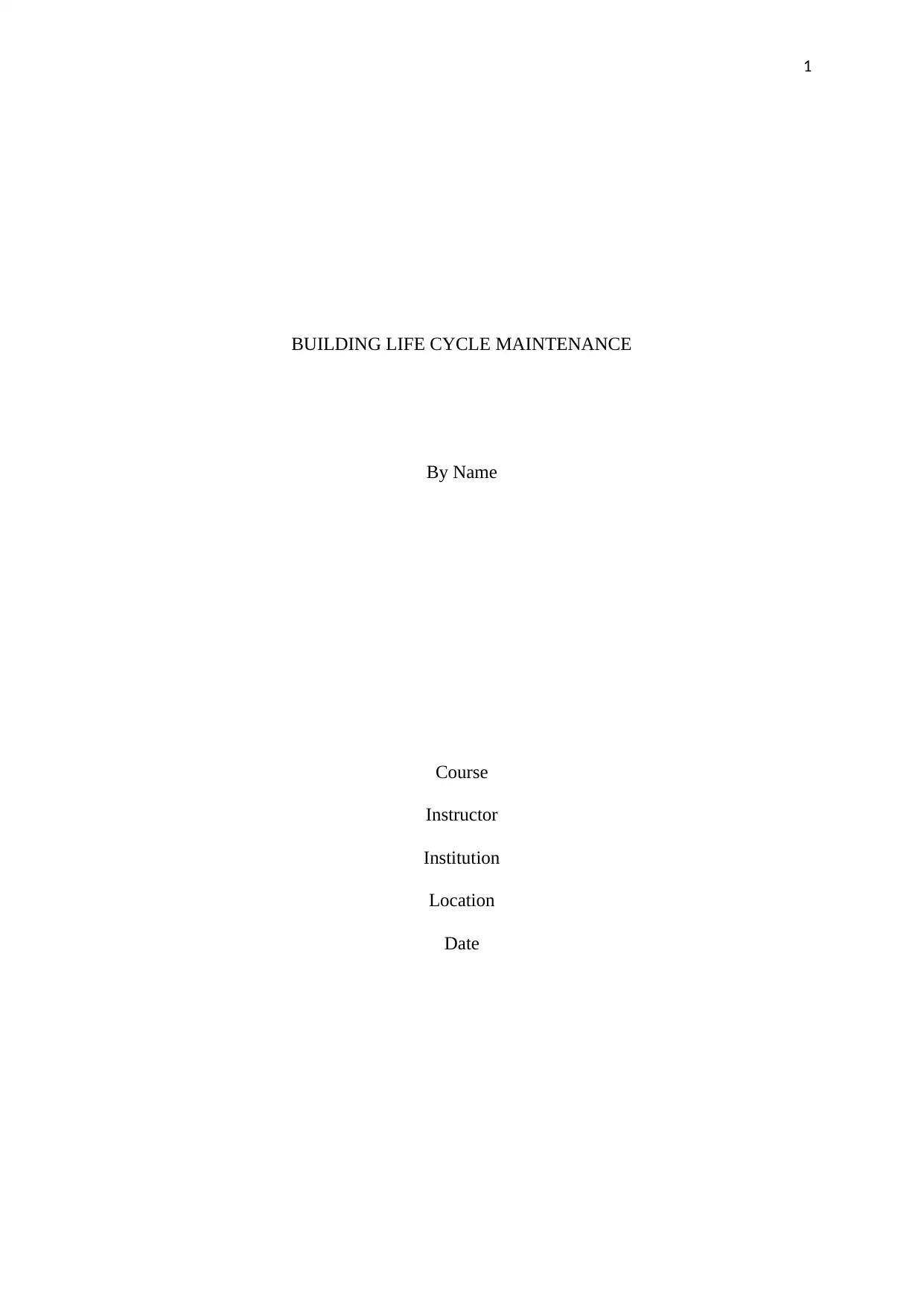
1
BUILDING LIFE CYCLE MAINTENANCE
By Name
Course
Instructor
Institution
Location
Date
BUILDING LIFE CYCLE MAINTENANCE
By Name
Course
Instructor
Institution
Location
Date
Paraphrase This Document
Need a fresh take? Get an instant paraphrase of this document with our AI Paraphraser
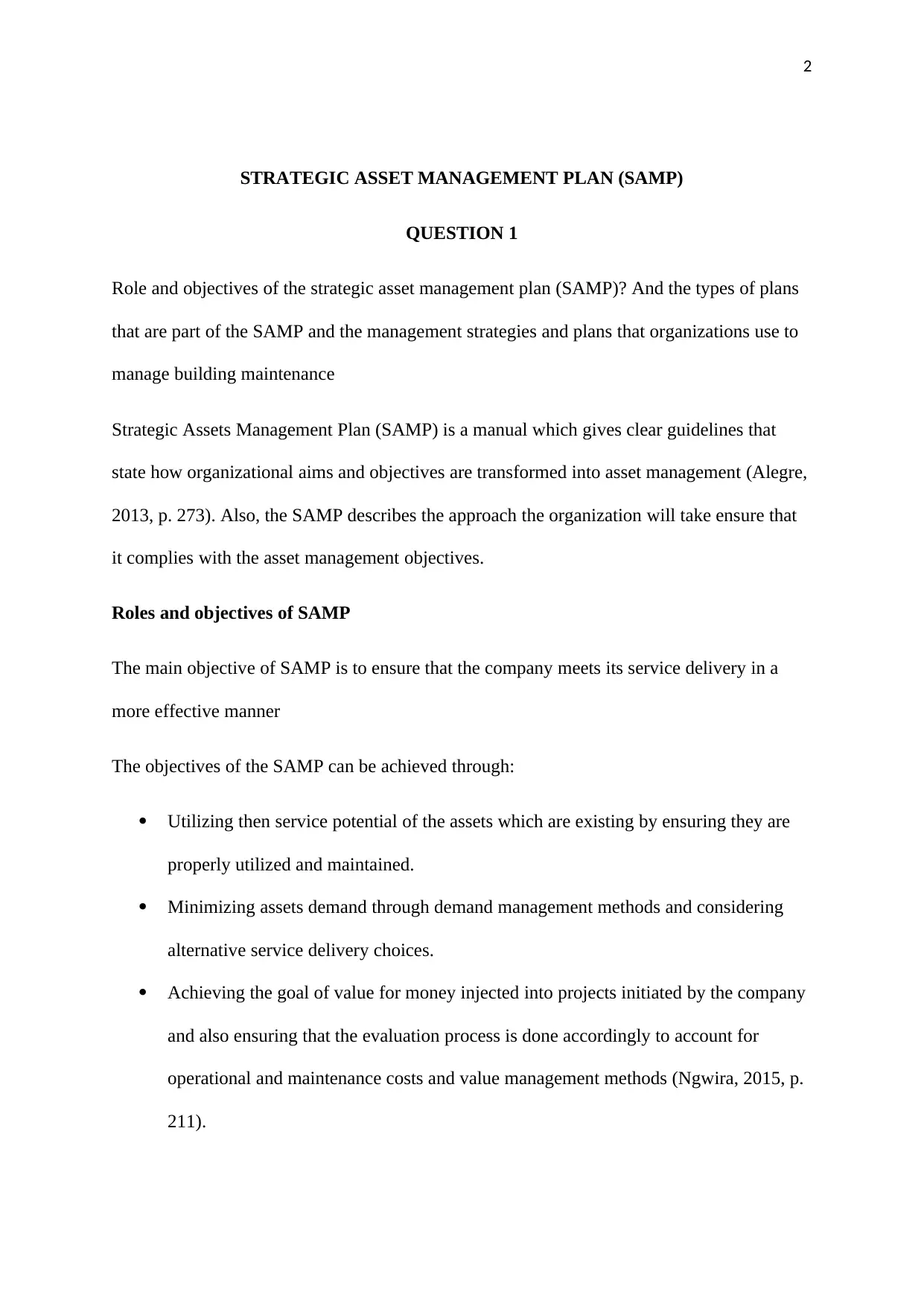
2
STRATEGIC ASSET MANAGEMENT PLAN (SAMP)
QUESTION 1
Role and objectives of the strategic asset management plan (SAMP)? And the types of plans
that are part of the SAMP and the management strategies and plans that organizations use to
manage building maintenance
Strategic Assets Management Plan (SAMP) is a manual which gives clear guidelines that
state how organizational aims and objectives are transformed into asset management (Alegre,
2013, p. 273). Also, the SAMP describes the approach the organization will take ensure that
it complies with the asset management objectives.
Roles and objectives of SAMP
The main objective of SAMP is to ensure that the company meets its service delivery in a
more effective manner
The objectives of the SAMP can be achieved through:
Utilizing then service potential of the assets which are existing by ensuring they are
properly utilized and maintained.
Minimizing assets demand through demand management methods and considering
alternative service delivery choices.
Achieving the goal of value for money injected into projects initiated by the company
and also ensuring that the evaluation process is done accordingly to account for
operational and maintenance costs and value management methods (Ngwira, 2015, p.
211).
STRATEGIC ASSET MANAGEMENT PLAN (SAMP)
QUESTION 1
Role and objectives of the strategic asset management plan (SAMP)? And the types of plans
that are part of the SAMP and the management strategies and plans that organizations use to
manage building maintenance
Strategic Assets Management Plan (SAMP) is a manual which gives clear guidelines that
state how organizational aims and objectives are transformed into asset management (Alegre,
2013, p. 273). Also, the SAMP describes the approach the organization will take ensure that
it complies with the asset management objectives.
Roles and objectives of SAMP
The main objective of SAMP is to ensure that the company meets its service delivery in a
more effective manner
The objectives of the SAMP can be achieved through:
Utilizing then service potential of the assets which are existing by ensuring they are
properly utilized and maintained.
Minimizing assets demand through demand management methods and considering
alternative service delivery choices.
Achieving the goal of value for money injected into projects initiated by the company
and also ensuring that the evaluation process is done accordingly to account for
operational and maintenance costs and value management methods (Ngwira, 2015, p.
211).
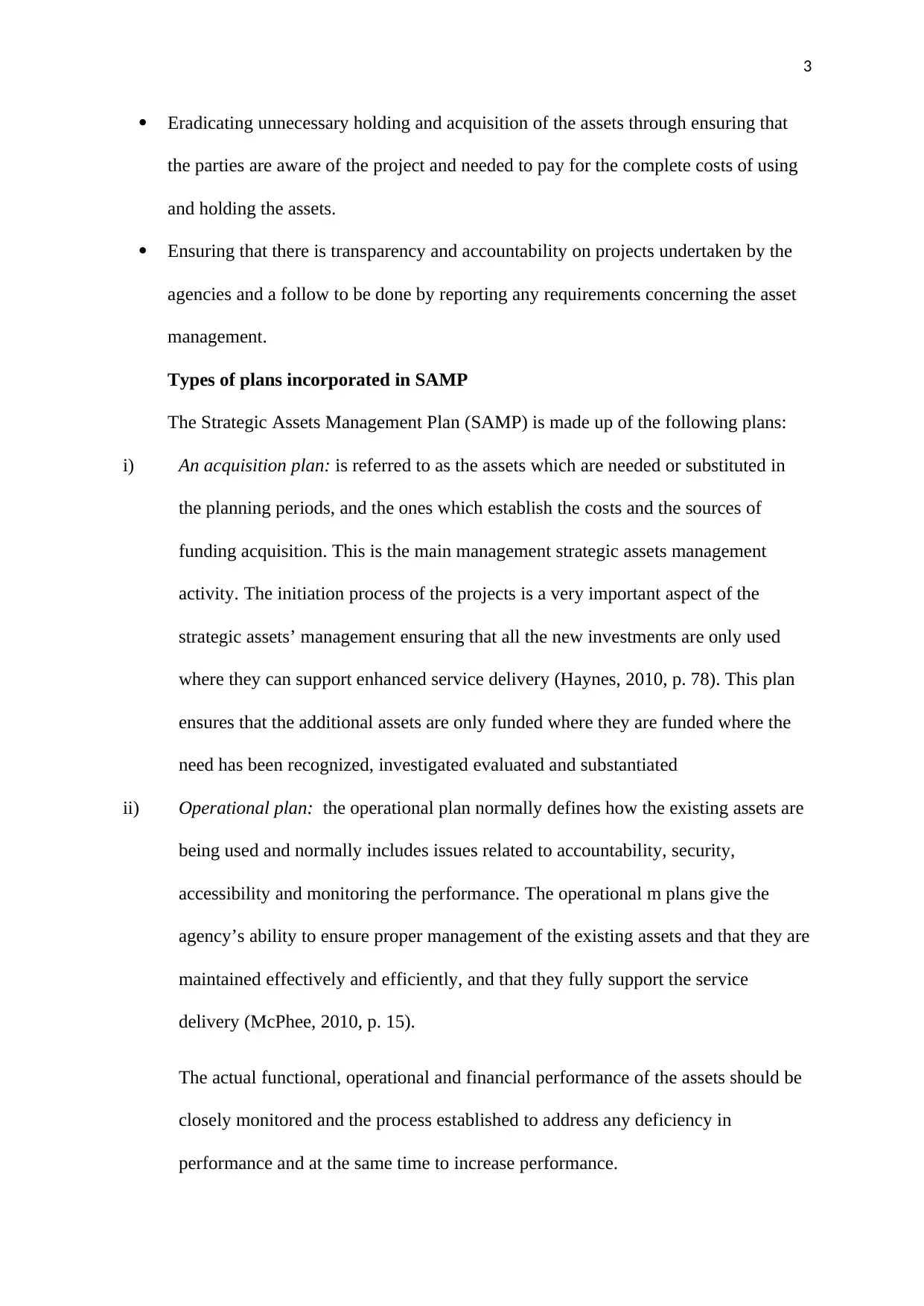
3
Eradicating unnecessary holding and acquisition of the assets through ensuring that
the parties are aware of the project and needed to pay for the complete costs of using
and holding the assets.
Ensuring that there is transparency and accountability on projects undertaken by the
agencies and a follow to be done by reporting any requirements concerning the asset
management.
Types of plans incorporated in SAMP
The Strategic Assets Management Plan (SAMP) is made up of the following plans:
i) An acquisition plan: is referred to as the assets which are needed or substituted in
the planning periods, and the ones which establish the costs and the sources of
funding acquisition. This is the main management strategic assets management
activity. The initiation process of the projects is a very important aspect of the
strategic assets’ management ensuring that all the new investments are only used
where they can support enhanced service delivery (Haynes, 2010, p. 78). This plan
ensures that the additional assets are only funded where they are funded where the
need has been recognized, investigated evaluated and substantiated
ii) Operational plan: the operational plan normally defines how the existing assets are
being used and normally includes issues related to accountability, security,
accessibility and monitoring the performance. The operational m plans give the
agency’s ability to ensure proper management of the existing assets and that they are
maintained effectively and efficiently, and that they fully support the service
delivery (McPhee, 2010, p. 15).
The actual functional, operational and financial performance of the assets should be
closely monitored and the process established to address any deficiency in
performance and at the same time to increase performance.
Eradicating unnecessary holding and acquisition of the assets through ensuring that
the parties are aware of the project and needed to pay for the complete costs of using
and holding the assets.
Ensuring that there is transparency and accountability on projects undertaken by the
agencies and a follow to be done by reporting any requirements concerning the asset
management.
Types of plans incorporated in SAMP
The Strategic Assets Management Plan (SAMP) is made up of the following plans:
i) An acquisition plan: is referred to as the assets which are needed or substituted in
the planning periods, and the ones which establish the costs and the sources of
funding acquisition. This is the main management strategic assets management
activity. The initiation process of the projects is a very important aspect of the
strategic assets’ management ensuring that all the new investments are only used
where they can support enhanced service delivery (Haynes, 2010, p. 78). This plan
ensures that the additional assets are only funded where they are funded where the
need has been recognized, investigated evaluated and substantiated
ii) Operational plan: the operational plan normally defines how the existing assets are
being used and normally includes issues related to accountability, security,
accessibility and monitoring the performance. The operational m plans give the
agency’s ability to ensure proper management of the existing assets and that they are
maintained effectively and efficiently, and that they fully support the service
delivery (McPhee, 2010, p. 15).
The actual functional, operational and financial performance of the assets should be
closely monitored and the process established to address any deficiency in
performance and at the same time to increase performance.
You're viewing a preview
Unlock full access by subscribing today!
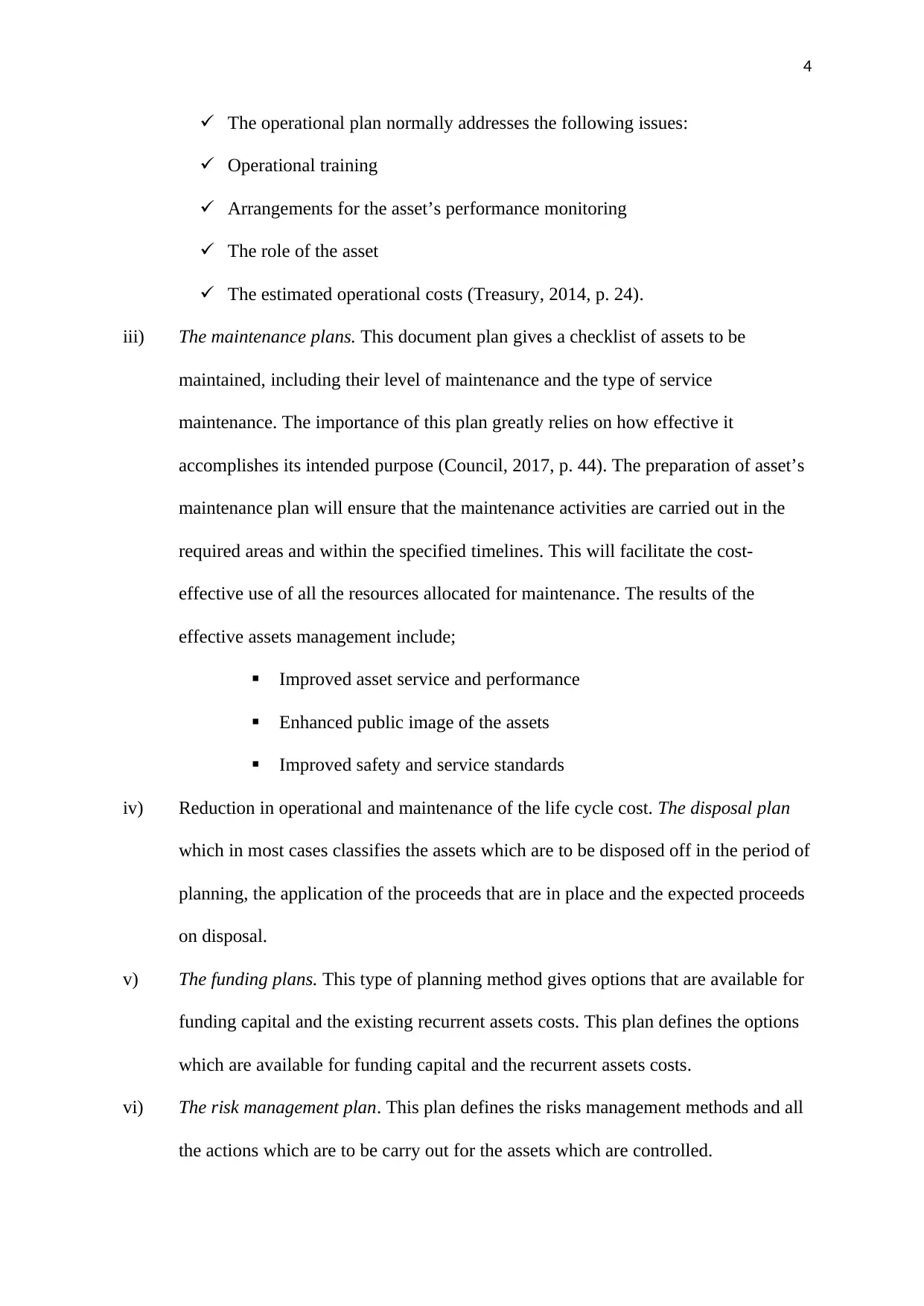
4
The operational plan normally addresses the following issues:
Operational training
Arrangements for the asset’s performance monitoring
The role of the asset
The estimated operational costs (Treasury, 2014, p. 24).
iii) The maintenance plans. This document plan gives a checklist of assets to be
maintained, including their level of maintenance and the type of service
maintenance. The importance of this plan greatly relies on how effective it
accomplishes its intended purpose (Council, 2017, p. 44). The preparation of asset’s
maintenance plan will ensure that the maintenance activities are carried out in the
required areas and within the specified timelines. This will facilitate the cost-
effective use of all the resources allocated for maintenance. The results of the
effective assets management include;
Improved asset service and performance
Enhanced public image of the assets
Improved safety and service standards
iv) Reduction in operational and maintenance of the life cycle cost. The disposal plan
which in most cases classifies the assets which are to be disposed off in the period of
planning, the application of the proceeds that are in place and the expected proceeds
on disposal.
v) The funding plans. This type of planning method gives options that are available for
funding capital and the existing recurrent assets costs. This plan defines the options
which are available for funding capital and the recurrent assets costs.
vi) The risk management plan. This plan defines the risks management methods and all
the actions which are to be carry out for the assets which are controlled.
The operational plan normally addresses the following issues:
Operational training
Arrangements for the asset’s performance monitoring
The role of the asset
The estimated operational costs (Treasury, 2014, p. 24).
iii) The maintenance plans. This document plan gives a checklist of assets to be
maintained, including their level of maintenance and the type of service
maintenance. The importance of this plan greatly relies on how effective it
accomplishes its intended purpose (Council, 2017, p. 44). The preparation of asset’s
maintenance plan will ensure that the maintenance activities are carried out in the
required areas and within the specified timelines. This will facilitate the cost-
effective use of all the resources allocated for maintenance. The results of the
effective assets management include;
Improved asset service and performance
Enhanced public image of the assets
Improved safety and service standards
iv) Reduction in operational and maintenance of the life cycle cost. The disposal plan
which in most cases classifies the assets which are to be disposed off in the period of
planning, the application of the proceeds that are in place and the expected proceeds
on disposal.
v) The funding plans. This type of planning method gives options that are available for
funding capital and the existing recurrent assets costs. This plan defines the options
which are available for funding capital and the recurrent assets costs.
vi) The risk management plan. This plan defines the risks management methods and all
the actions which are to be carry out for the assets which are controlled.
Paraphrase This Document
Need a fresh take? Get an instant paraphrase of this document with our AI Paraphraser
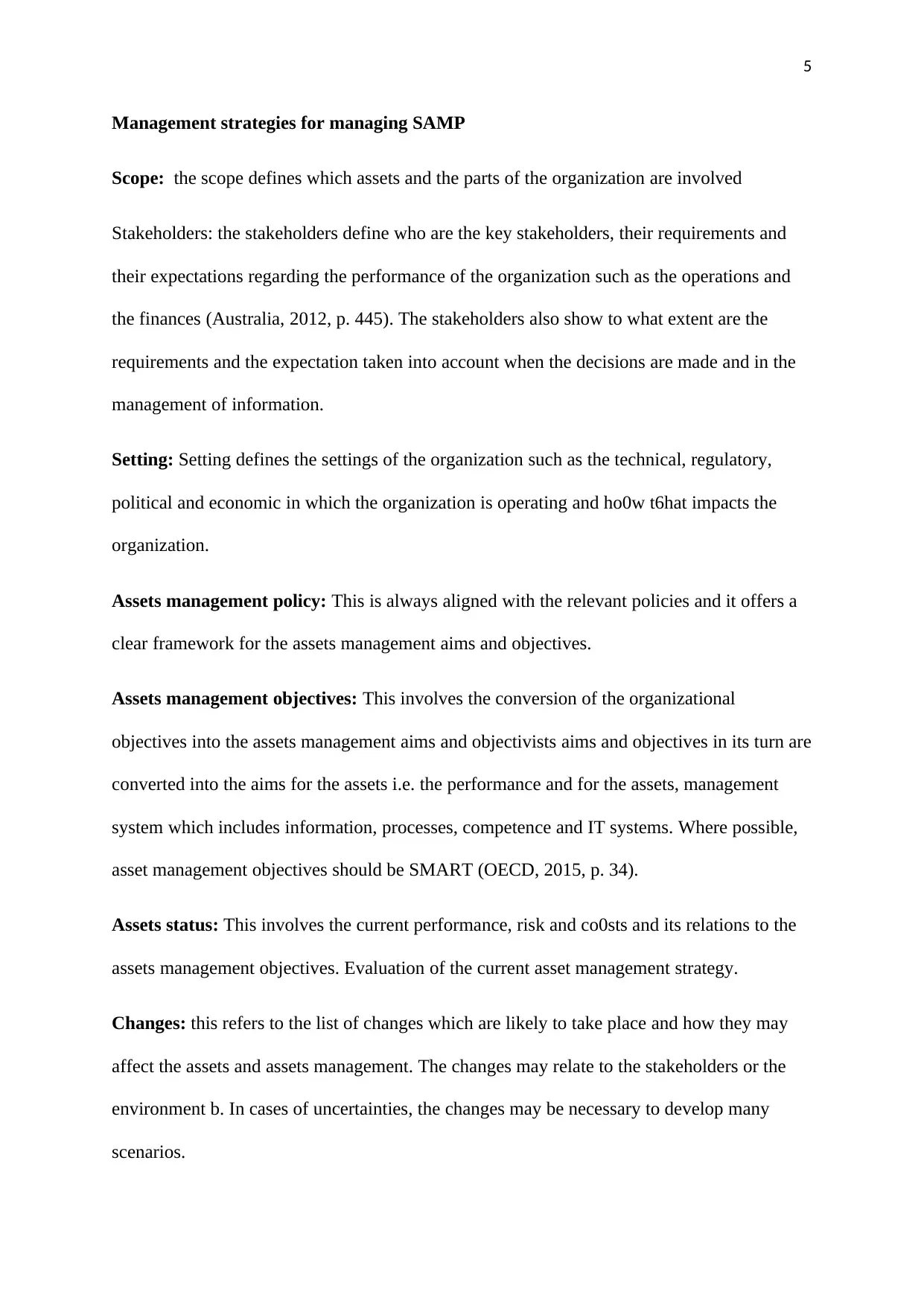
5
Management strategies for managing SAMP
Scope: the scope defines which assets and the parts of the organization are involved
Stakeholders: the stakeholders define who are the key stakeholders, their requirements and
their expectations regarding the performance of the organization such as the operations and
the finances (Australia, 2012, p. 445). The stakeholders also show to what extent are the
requirements and the expectation taken into account when the decisions are made and in the
management of information.
Setting: Setting defines the settings of the organization such as the technical, regulatory,
political and economic in which the organization is operating and ho0w t6hat impacts the
organization.
Assets management policy: This is always aligned with the relevant policies and it offers a
clear framework for the assets management aims and objectives.
Assets management objectives: This involves the conversion of the organizational
objectives into the assets management aims and objectivists aims and objectives in its turn are
converted into the aims for the assets i.e. the performance and for the assets, management
system which includes information, processes, competence and IT systems. Where possible,
asset management objectives should be SMART (OECD, 2015, p. 34).
Assets status: This involves the current performance, risk and co0sts and its relations to the
assets management objectives. Evaluation of the current asset management strategy.
Changes: this refers to the list of changes which are likely to take place and how they may
affect the assets and assets management. The changes may relate to the stakeholders or the
environment b. In cases of uncertainties, the changes may be necessary to develop many
scenarios.
Management strategies for managing SAMP
Scope: the scope defines which assets and the parts of the organization are involved
Stakeholders: the stakeholders define who are the key stakeholders, their requirements and
their expectations regarding the performance of the organization such as the operations and
the finances (Australia, 2012, p. 445). The stakeholders also show to what extent are the
requirements and the expectation taken into account when the decisions are made and in the
management of information.
Setting: Setting defines the settings of the organization such as the technical, regulatory,
political and economic in which the organization is operating and ho0w t6hat impacts the
organization.
Assets management policy: This is always aligned with the relevant policies and it offers a
clear framework for the assets management aims and objectives.
Assets management objectives: This involves the conversion of the organizational
objectives into the assets management aims and objectivists aims and objectives in its turn are
converted into the aims for the assets i.e. the performance and for the assets, management
system which includes information, processes, competence and IT systems. Where possible,
asset management objectives should be SMART (OECD, 2015, p. 34).
Assets status: This involves the current performance, risk and co0sts and its relations to the
assets management objectives. Evaluation of the current asset management strategy.
Changes: this refers to the list of changes which are likely to take place and how they may
affect the assets and assets management. The changes may relate to the stakeholders or the
environment b. In cases of uncertainties, the changes may be necessary to develop many
scenarios.
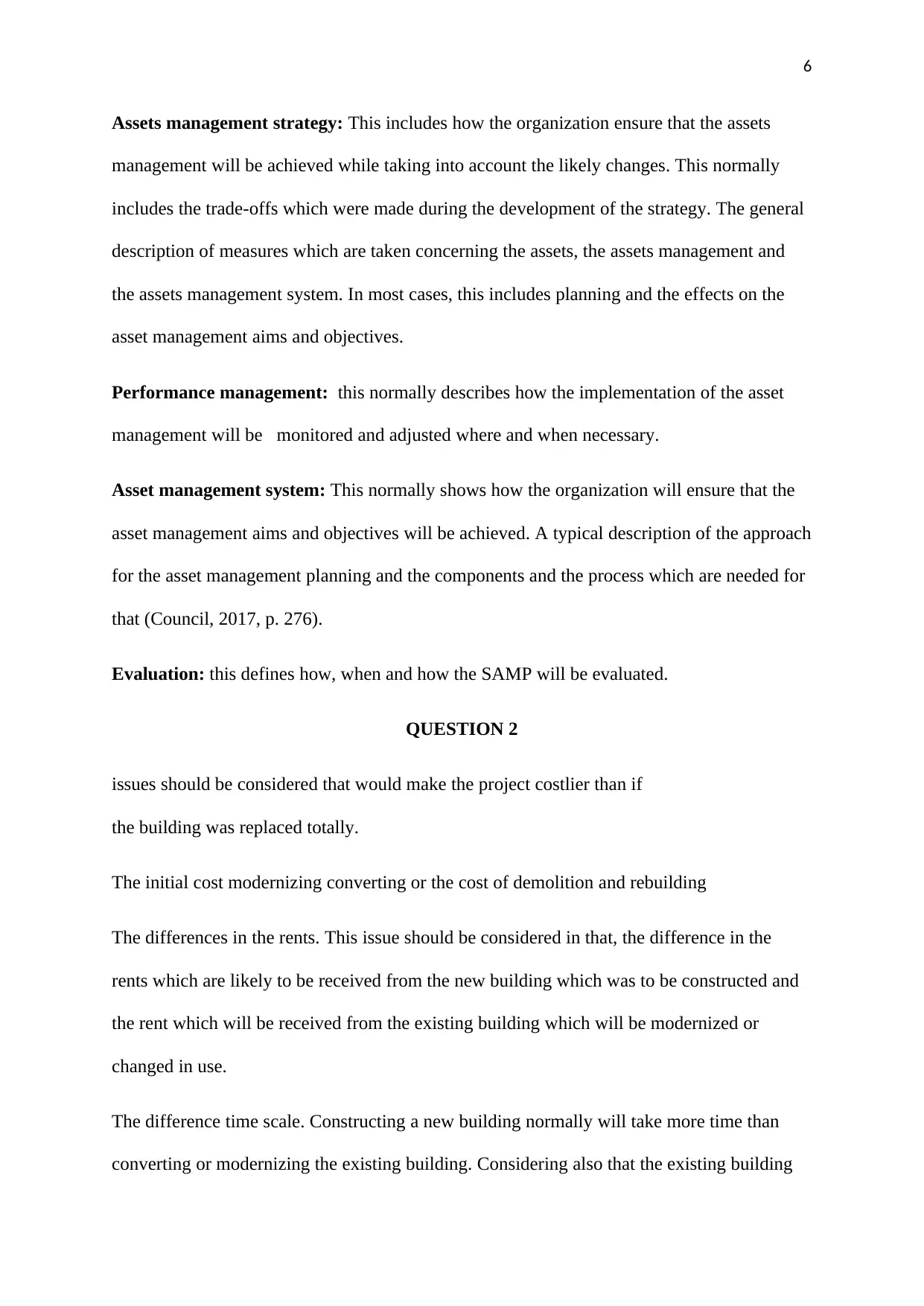
6
Assets management strategy: This includes how the organization ensure that the assets
management will be achieved while taking into account the likely changes. This normally
includes the trade-offs which were made during the development of the strategy. The general
description of measures which are taken concerning the assets, the assets management and
the assets management system. In most cases, this includes planning and the effects on the
asset management aims and objectives.
Performance management: this normally describes how the implementation of the asset
management will be monitored and adjusted where and when necessary.
Asset management system: This normally shows how the organization will ensure that the
asset management aims and objectives will be achieved. A typical description of the approach
for the asset management planning and the components and the process which are needed for
that (Council, 2017, p. 276).
Evaluation: this defines how, when and how the SAMP will be evaluated.
QUESTION 2
issues should be considered that would make the project costlier than if
the building was replaced totally.
The initial cost modernizing converting or the cost of demolition and rebuilding
The differences in the rents. This issue should be considered in that, the difference in the
rents which are likely to be received from the new building which was to be constructed and
the rent which will be received from the existing building which will be modernized or
changed in use.
The difference time scale. Constructing a new building normally will take more time than
converting or modernizing the existing building. Considering also that the existing building
Assets management strategy: This includes how the organization ensure that the assets
management will be achieved while taking into account the likely changes. This normally
includes the trade-offs which were made during the development of the strategy. The general
description of measures which are taken concerning the assets, the assets management and
the assets management system. In most cases, this includes planning and the effects on the
asset management aims and objectives.
Performance management: this normally describes how the implementation of the asset
management will be monitored and adjusted where and when necessary.
Asset management system: This normally shows how the organization will ensure that the
asset management aims and objectives will be achieved. A typical description of the approach
for the asset management planning and the components and the process which are needed for
that (Council, 2017, p. 276).
Evaluation: this defines how, when and how the SAMP will be evaluated.
QUESTION 2
issues should be considered that would make the project costlier than if
the building was replaced totally.
The initial cost modernizing converting or the cost of demolition and rebuilding
The differences in the rents. This issue should be considered in that, the difference in the
rents which are likely to be received from the new building which was to be constructed and
the rent which will be received from the existing building which will be modernized or
changed in use.
The difference time scale. Constructing a new building normally will take more time than
converting or modernizing the existing building. Considering also that the existing building
You're viewing a preview
Unlock full access by subscribing today!
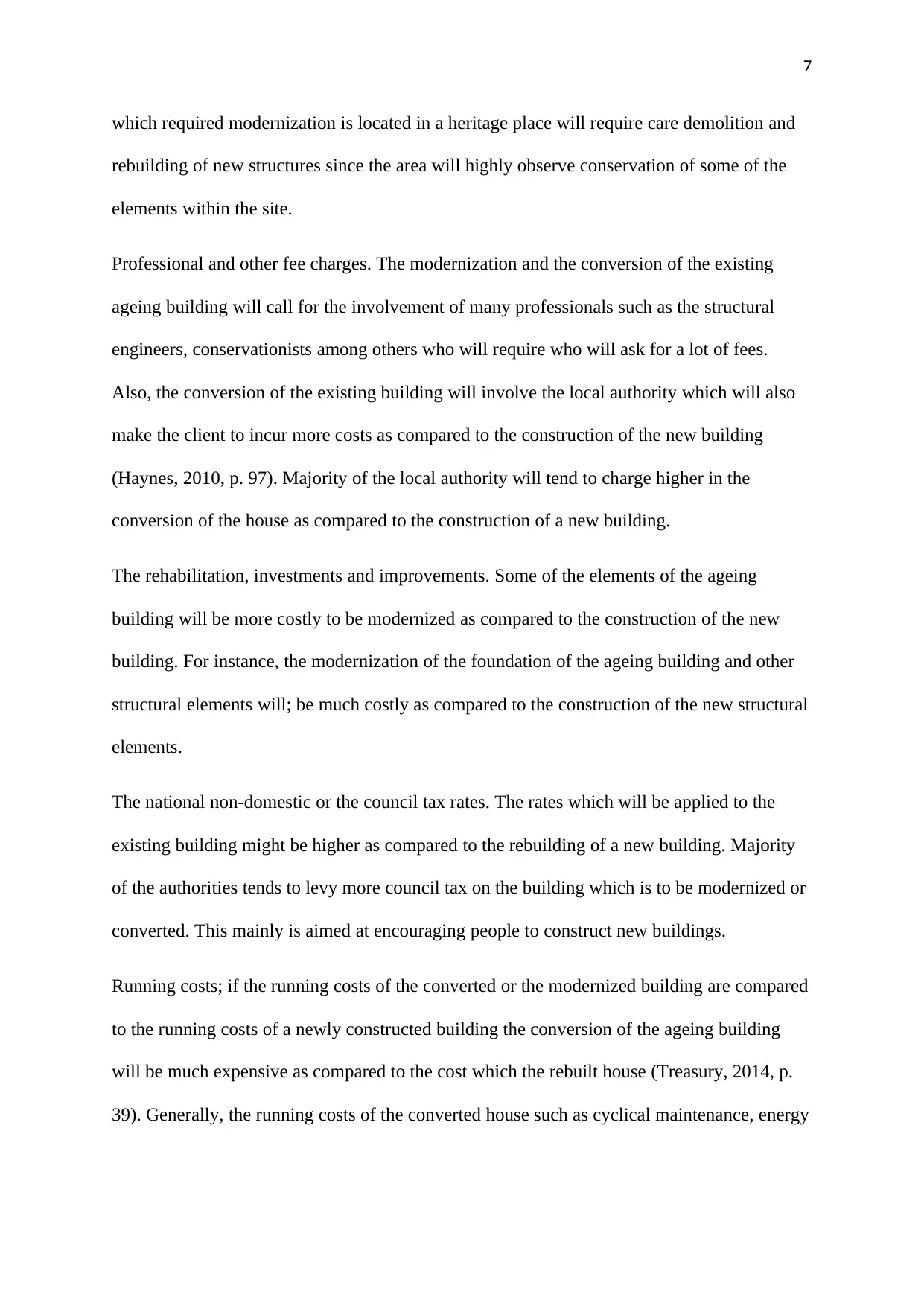
7
which required modernization is located in a heritage place will require care demolition and
rebuilding of new structures since the area will highly observe conservation of some of the
elements within the site.
Professional and other fee charges. The modernization and the conversion of the existing
ageing building will call for the involvement of many professionals such as the structural
engineers, conservationists among others who will require who will ask for a lot of fees.
Also, the conversion of the existing building will involve the local authority which will also
make the client to incur more costs as compared to the construction of the new building
(Haynes, 2010, p. 97). Majority of the local authority will tend to charge higher in the
conversion of the house as compared to the construction of a new building.
The rehabilitation, investments and improvements. Some of the elements of the ageing
building will be more costly to be modernized as compared to the construction of the new
building. For instance, the modernization of the foundation of the ageing building and other
structural elements will; be much costly as compared to the construction of the new structural
elements.
The national non-domestic or the council tax rates. The rates which will be applied to the
existing building might be higher as compared to the rebuilding of a new building. Majority
of the authorities tends to levy more council tax on the building which is to be modernized or
converted. This mainly is aimed at encouraging people to construct new buildings.
Running costs; if the running costs of the converted or the modernized building are compared
to the running costs of a newly constructed building the conversion of the ageing building
will be much expensive as compared to the cost which the rebuilt house (Treasury, 2014, p.
39). Generally, the running costs of the converted house such as cyclical maintenance, energy
which required modernization is located in a heritage place will require care demolition and
rebuilding of new structures since the area will highly observe conservation of some of the
elements within the site.
Professional and other fee charges. The modernization and the conversion of the existing
ageing building will call for the involvement of many professionals such as the structural
engineers, conservationists among others who will require who will ask for a lot of fees.
Also, the conversion of the existing building will involve the local authority which will also
make the client to incur more costs as compared to the construction of the new building
(Haynes, 2010, p. 97). Majority of the local authority will tend to charge higher in the
conversion of the house as compared to the construction of a new building.
The rehabilitation, investments and improvements. Some of the elements of the ageing
building will be more costly to be modernized as compared to the construction of the new
building. For instance, the modernization of the foundation of the ageing building and other
structural elements will; be much costly as compared to the construction of the new structural
elements.
The national non-domestic or the council tax rates. The rates which will be applied to the
existing building might be higher as compared to the rebuilding of a new building. Majority
of the authorities tends to levy more council tax on the building which is to be modernized or
converted. This mainly is aimed at encouraging people to construct new buildings.
Running costs; if the running costs of the converted or the modernized building are compared
to the running costs of a newly constructed building the conversion of the ageing building
will be much expensive as compared to the cost which the rebuilt house (Treasury, 2014, p.
39). Generally, the running costs of the converted house such as cyclical maintenance, energy
Paraphrase This Document
Need a fresh take? Get an instant paraphrase of this document with our AI Paraphraser
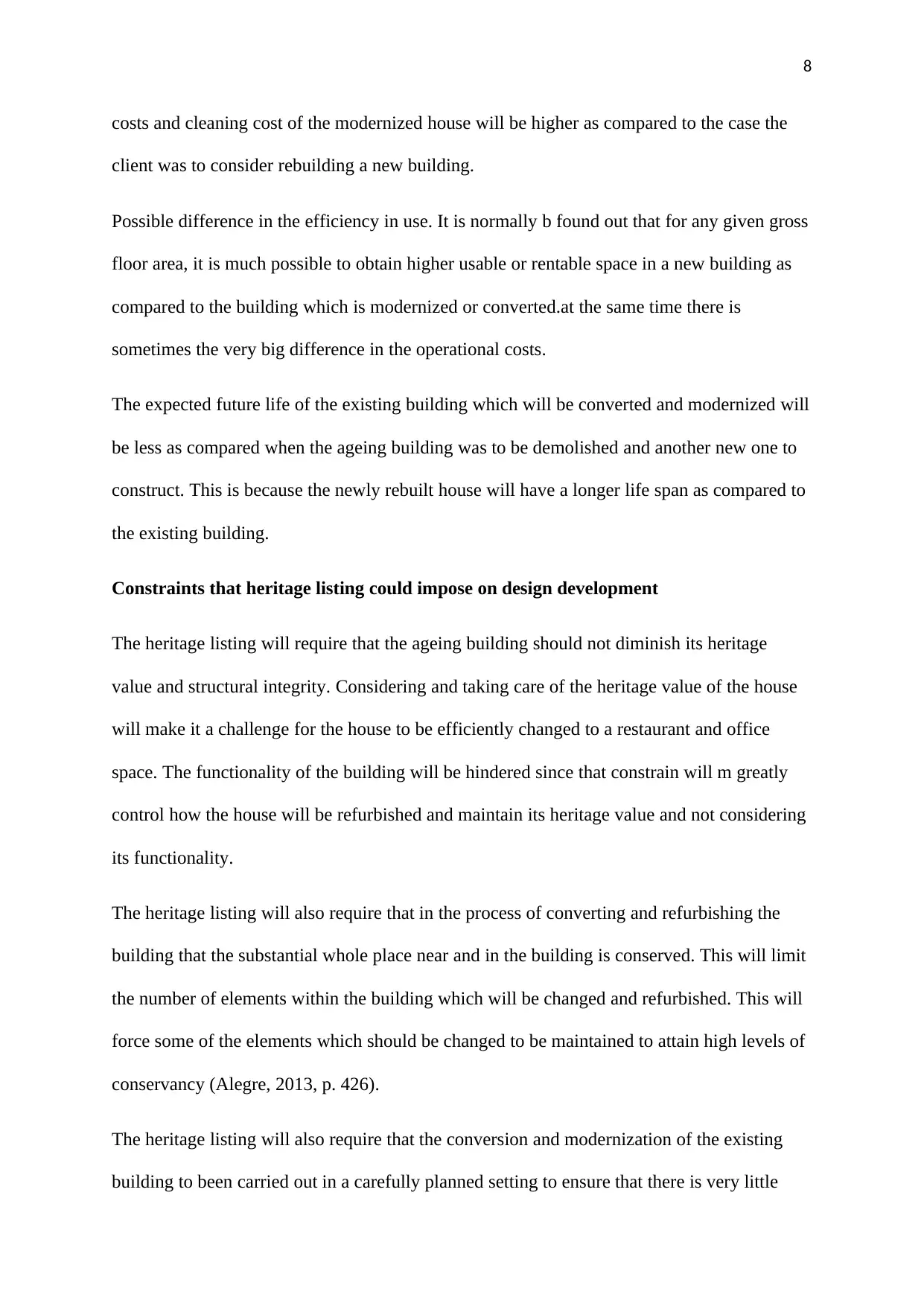
8
costs and cleaning cost of the modernized house will be higher as compared to the case the
client was to consider rebuilding a new building.
Possible difference in the efficiency in use. It is normally b found out that for any given gross
floor area, it is much possible to obtain higher usable or rentable space in a new building as
compared to the building which is modernized or converted.at the same time there is
sometimes the very big difference in the operational costs.
The expected future life of the existing building which will be converted and modernized will
be less as compared when the ageing building was to be demolished and another new one to
construct. This is because the newly rebuilt house will have a longer life span as compared to
the existing building.
Constraints that heritage listing could impose on design development
The heritage listing will require that the ageing building should not diminish its heritage
value and structural integrity. Considering and taking care of the heritage value of the house
will make it a challenge for the house to be efficiently changed to a restaurant and office
space. The functionality of the building will be hindered since that constrain will m greatly
control how the house will be refurbished and maintain its heritage value and not considering
its functionality.
The heritage listing will also require that in the process of converting and refurbishing the
building that the substantial whole place near and in the building is conserved. This will limit
the number of elements within the building which will be changed and refurbished. This will
force some of the elements which should be changed to be maintained to attain high levels of
conservancy (Alegre, 2013, p. 426).
The heritage listing will also require that the conversion and modernization of the existing
building to been carried out in a carefully planned setting to ensure that there is very little
costs and cleaning cost of the modernized house will be higher as compared to the case the
client was to consider rebuilding a new building.
Possible difference in the efficiency in use. It is normally b found out that for any given gross
floor area, it is much possible to obtain higher usable or rentable space in a new building as
compared to the building which is modernized or converted.at the same time there is
sometimes the very big difference in the operational costs.
The expected future life of the existing building which will be converted and modernized will
be less as compared when the ageing building was to be demolished and another new one to
construct. This is because the newly rebuilt house will have a longer life span as compared to
the existing building.
Constraints that heritage listing could impose on design development
The heritage listing will require that the ageing building should not diminish its heritage
value and structural integrity. Considering and taking care of the heritage value of the house
will make it a challenge for the house to be efficiently changed to a restaurant and office
space. The functionality of the building will be hindered since that constrain will m greatly
control how the house will be refurbished and maintain its heritage value and not considering
its functionality.
The heritage listing will also require that in the process of converting and refurbishing the
building that the substantial whole place near and in the building is conserved. This will limit
the number of elements within the building which will be changed and refurbished. This will
force some of the elements which should be changed to be maintained to attain high levels of
conservancy (Alegre, 2013, p. 426).
The heritage listing will also require that the conversion and modernization of the existing
building to been carried out in a carefully planned setting to ensure that there is very little

9
damage is done to the environment. This will require consultations from the professionals
such as st6ructural engineers and architects regarding the developments and modifications
which will be done on the building and imply the heritage of the building. This will slow
down the conversion and modernization of the existing building and at the same time
increase, the costs will be incurred since those professionals will be required to be paid for
their services.
Provisional Development Plan Consent, this will be required for the maintenance of the
heritage buildings such as the ageing building. This will be imposed by the heritage listing
authority as it is under the control of the development activities. The process of converting
the building and modernizing it will require this certificate since it is listed among the
heritage places.
damage is done to the environment. This will require consultations from the professionals
such as st6ructural engineers and architects regarding the developments and modifications
which will be done on the building and imply the heritage of the building. This will slow
down the conversion and modernization of the existing building and at the same time
increase, the costs will be incurred since those professionals will be required to be paid for
their services.
Provisional Development Plan Consent, this will be required for the maintenance of the
heritage buildings such as the ageing building. This will be imposed by the heritage listing
authority as it is under the control of the development activities. The process of converting
the building and modernizing it will require this certificate since it is listed among the
heritage places.
You're viewing a preview
Unlock full access by subscribing today!
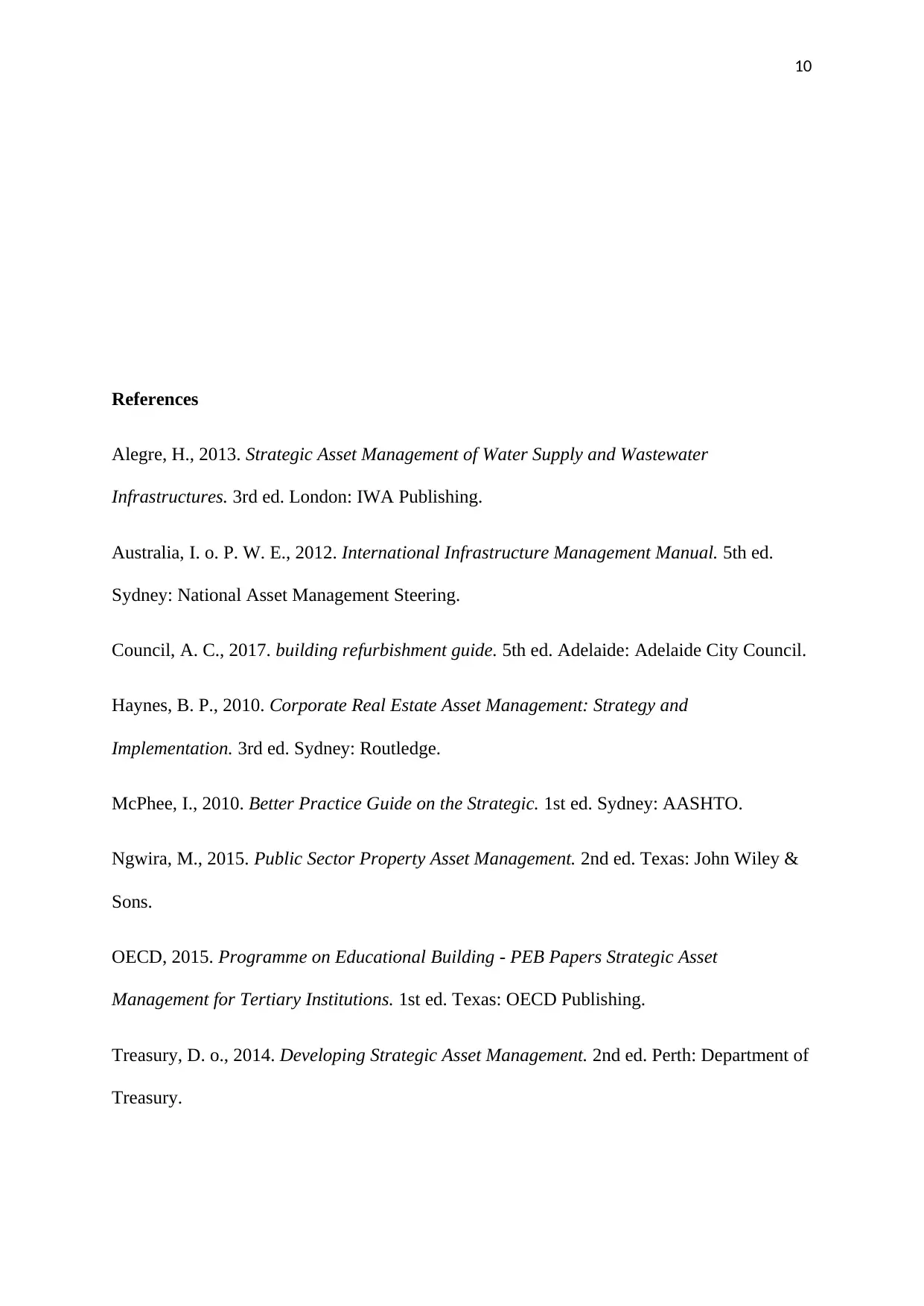
10
References
Alegre, H., 2013. Strategic Asset Management of Water Supply and Wastewater
Infrastructures. 3rd ed. London: IWA Publishing.
Australia, I. o. P. W. E., 2012. International Infrastructure Management Manual. 5th ed.
Sydney: National Asset Management Steering.
Council, A. C., 2017. building refurbishment guide. 5th ed. Adelaide: Adelaide City Council.
Haynes, B. P., 2010. Corporate Real Estate Asset Management: Strategy and
Implementation. 3rd ed. Sydney: Routledge.
McPhee, I., 2010. Better Practice Guide on the Strategic. 1st ed. Sydney: AASHTO.
Ngwira, M., 2015. Public Sector Property Asset Management. 2nd ed. Texas: John Wiley &
Sons.
OECD, 2015. Programme on Educational Building - PEB Papers Strategic Asset
Management for Tertiary Institutions. 1st ed. Texas: OECD Publishing.
Treasury, D. o., 2014. Developing Strategic Asset Management. 2nd ed. Perth: Department of
Treasury.
References
Alegre, H., 2013. Strategic Asset Management of Water Supply and Wastewater
Infrastructures. 3rd ed. London: IWA Publishing.
Australia, I. o. P. W. E., 2012. International Infrastructure Management Manual. 5th ed.
Sydney: National Asset Management Steering.
Council, A. C., 2017. building refurbishment guide. 5th ed. Adelaide: Adelaide City Council.
Haynes, B. P., 2010. Corporate Real Estate Asset Management: Strategy and
Implementation. 3rd ed. Sydney: Routledge.
McPhee, I., 2010. Better Practice Guide on the Strategic. 1st ed. Sydney: AASHTO.
Ngwira, M., 2015. Public Sector Property Asset Management. 2nd ed. Texas: John Wiley &
Sons.
OECD, 2015. Programme on Educational Building - PEB Papers Strategic Asset
Management for Tertiary Institutions. 1st ed. Texas: OECD Publishing.
Treasury, D. o., 2014. Developing Strategic Asset Management. 2nd ed. Perth: Department of
Treasury.
Paraphrase This Document
Need a fresh take? Get an instant paraphrase of this document with our AI Paraphraser

11
1 out of 11
Related Documents
Your All-in-One AI-Powered Toolkit for Academic Success.
+13062052269
info@desklib.com
Available 24*7 on WhatsApp / Email
![[object Object]](/_next/static/media/star-bottom.7253800d.svg)
Unlock your academic potential
© 2024 | Zucol Services PVT LTD | All rights reserved.




